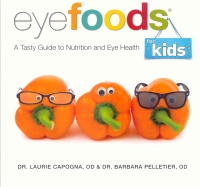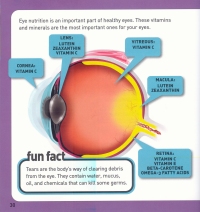| ________________
CM . . .
. Volume XX Number 4. . . .September 27, 2013
excerpt:
Most people likely don’t consider their eye health until they have a problem with their vision. Fewer still would be aware of which foods might be best to promote eye health. With few books on the topic – and fewer still aimed at the school-age crowd – Eyefoods for Kids: A Tasty Guide to Nutrition and Eye Health is a unique and interesting read. Written by two optometrists with an interest in nutrition, the book gives readers an authoritative view of the best eating habits to encourage good eyesight.
The first few chapters of the book serve as an overview of how the eye works. This is important background information to frame the chapters that follow. Although the anatomy of the eye can be quite complicated, the authors do a good job of paring the text down to the essentials and do so in a language which is appropriate for the target age group. The next section of the title dives right into the topic at hand and speaks to the various nutritional approaches to eye health. There are a variety of vitamins and minerals that can help specific parts of the eye. It turns out that your mom was right! Dark green and orange vegetables (such as spinach and carrots) are good for your eyes! Of course, fruits and vegetables and other healthy foods are good for your overall health as well. The following chapter veers off the theme a bit and tackles a different topic. Despite the title, this section of the book contains no nutritional advice but rather focuses on other ways to keep your eyes healthy. These include protecting your eyes from the sun by wearing sunglasses and wearing protective gear during sports or other activities. Although this information is undoubtedly useful and important, this chapter seems like a bit of a tangent that may confuse younger readers. The chapter that follows returns readers to the food theme by featuring some fun and tasty recipes for healthy eyes (pineapple passion smoothies anyone?). The recipes seem fairly kid-friendly as they are simple, delicious, and easy to make. A few of the recipes seem geared towards older children as they require use of knives and/or blenders, but the more dangerous steps include a note to ask an adult for help. The book ends with a short chapter that encourages readers to think of their eyes like any other body part. Just like your heart or your legs, your eyes need exercise every day. Simple instructions for strengthening eye muscles are included in case students want to give it a try. The authors also remind readers to rest their eyes and to avoid long periods of activities that could cause eye strain. The intense focus required for video games and daily computer use can contribute to irritated and tired eyes. The reminder to limit screen time is timely and appropriate as both adults and children seem to be increasingly “wired-in”. Eyefoods for Kids: A Tasty Guide to Nutrition and Eye Health is an informative and entertaining text which reaches out to its target readership without being overly simplistic. The authors are able to explain difficult concepts, such as macular degeneration, in a way that is interesting and accessible to young readers. Overall, a “delicious” read that would be a welcome addition to any classroom, school or public library. Recommended. Michelle Brown is a librarian in the Faculty of Education at the University of Ottawa in Ottawa, ON.
To comment
on this title or this review, send mail to cm@umanitoba.ca.
Copyright © the Manitoba Library Association. Reproduction for personal
use is permitted only if this copyright notice is maintained. Any
other reproduction is prohibited without permission.
NEXT REVIEW | TABLE OF CONTENTS FOR THIS ISSUE
- September 27 2013.
AUTHORS |
TITLES |
MEDIA REVIEWS |
PROFILES |
BACK ISSUES |
SEARCH |
CMARCHIVE |
HOME |

 The overall look and layout of the book is very appealing and will certainly draw in young readers. Each glossy page is filled with interesting full-colour images. The text is large and easy to read, and there is a good use of white space. The book includes a lot of images and a variety of fonts without its seeming too overwhelming or busy. A dozen or so more difficult words are bolded in the body of the text, a signal for readers to find the definition in the glossary at the end of the book. This is a nice feature which expands understanding of the content and also introduces more novice readers to the concept of a glossary.
The overall look and layout of the book is very appealing and will certainly draw in young readers. Each glossy page is filled with interesting full-colour images. The text is large and easy to read, and there is a good use of white space. The book includes a lot of images and a variety of fonts without its seeming too overwhelming or busy. A dozen or so more difficult words are bolded in the body of the text, a signal for readers to find the definition in the glossary at the end of the book. This is a nice feature which expands understanding of the content and also introduces more novice readers to the concept of a glossary.